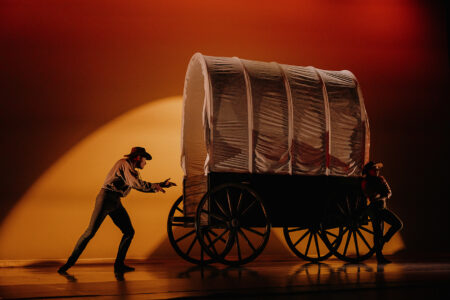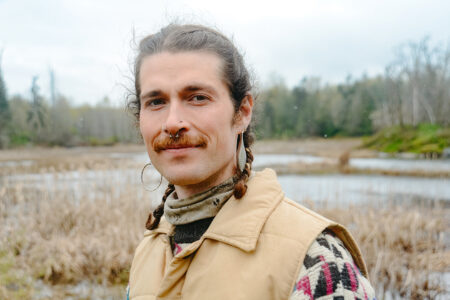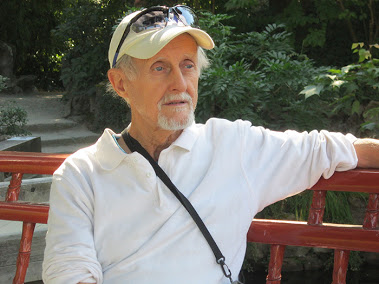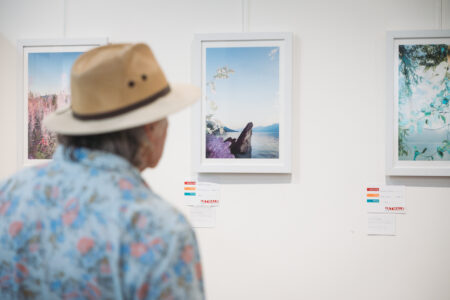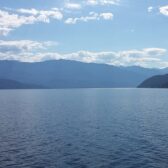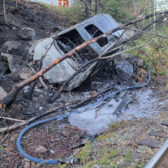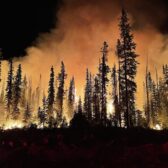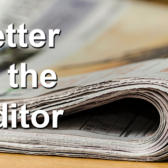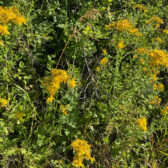A Life of Art with Kristy Gordon
Every artist wants to create a statement and an impact, and Nelson native Kristy Gordon’s art embodies a spirit that is both feminist and from a timeless punk era. Her style and artistry portrays uncomfortably provocative imagery, yet startling beautiful landscapes that are both visceral and surreal.
Her oil paintings truly champion the activist movements that we’re experiencing at this time. Interweaving motifs from disparate genres and time periods — from Old Master history painting to contemporary portraiture, she creates temporally ambiguous settings for strange and surprising interactions among people, animals, and hybrid creatures.
Looking through her visual lens, the narratives counters historical representations of figure’s and individuals, namely white bodies performing conventional gender roles, as she populates her work with people from diverse backgrounds.
Her captivating work also centres around the female perspective, positioning woman in the centre of interest. To dismantle gendered hierarchies long embedded in our visual culture, she inserts feminine or camp motifs — flowers, unicorns, and fairies, for example — into traditionally masculine genres such as history painting.
The presence of monsters and mythic beings further suggests that these are spaces where identity is fluid. Through these meticulously detailed and absurd multi-figure compositions, Kristy has mastered the language of narrative oil painting to produce art that examines socio-cultural events through the lens of social justice and ecological awareness.
While fantastical, the environs she depicts are not purely imaginary; they stage a return of the repressed. Surging with struggle, conflict, faith, and power, her work creates allegorical spectacles where the realms of reality and the imagination collide. Themes and techniques that have been purged from art history on the grounds of good taste re-emerge through her image landscapes, and they conjure the magic that has been expunged from the rationalist, technocratic logic of our lived reality.
However, the resulting spaces are far from utopian. Her paintings foreground tense power dynamics as well as the protean vulnerability of the individual body and psyche itself. By reflecting the pervasive role of violence in our socio-political sphere, she represents fraught encounters in which the identities and roles of perpetrator and victim are rarely clear.
In this edition of The Daily Dose, Editor Jeff Sawyer sits down with Kristy to explore her deeply steeped conceptual realism motifs and narrative figurative portraiture styles, and what guides her instincts and approach as a painter and a remarkably gifted artist.
When did you discover your craft and talent as an artist, especially in mastering portraits in the hyperrealism genre?
I always loved art and I was always pretty good at it. As a kid I only ever asked for art supplies for Christmas and birthdays and I always knew I wanted to be an artist. I didn’t always know that being an artist was an option though, so initially I went into animation after high school thinking it was a good compromise – a creative art career. I think the universe has a way of putting us back on track when we get a little off track, so I was working in animation at a studio that was owned by a locally renowned oil painter Philip Craig. Eventually I started painting with Phil in between doing my animation work. Through Phil I was introduced to the owner of an art gallery in Ottawa and he started exhibiting my landscape paintings in his galleries. The jobs I was holding in animation changed over time (different positions, at different studios, on different shows) so on weekdays I was working in animation and in my evenings and weekends I was painting. Eventually my animations jobs just got so hard and annoying and my paintings were selling so well that I basically realized I didn’t need to hold on to the animation job and I could start painting full time instead.
The next big leap came as I started to feel strongly pulled towards painting people (which is what I used to paint in high school). It was a big shift. I wondered who would ever buy a painting of someone they’ve never met. I did it anyway. I was pretty shocked when I had my first solo show of the new figurative work and people actually bought them too! I definitely don’t paint with selling in mind anymore, but at that time I was a little concerned about it, especially since I had just quit my animation job and I did need an income.
You received a BFA from the Ontario College of Art and Design in 2011, and an MFA from The New York Academy of Art in 2013. Take me through the formative years of school and your experiences, how did they change and shape you into the artist you are today?
Having found my way into painting through the backdoor, I had kind of skipped the education phase of my development as a painter and skipped straight to the exhibiting in galleries phase. So, in those initial years I always felt undereducated about the contemporary discourse on art. I initially took some workshops at various realist academies and ateliers. Studying at academies was an excellent way to learn technique but not supportive in developing and integrating my own ideas and concepts into my work. The decision to attend a full-time accredited art college brought me to a very large transition in my life where everything ended and a new life emerged. I left a relationship, we sold our house, and at 28 I moved from Ottawa to Toronto to live on my own for the first time in my life to study at the Ontario College of Art and Design. I see this phase in my life a lot like the beginning of Joseph Campbell’s archetypal story of the hero’s journey of transformation. It was all way harder than I ever expected it to be.
Luckily, I just took the first little step that I knew I should do, and the next steps revealed themselves one by one as I went. So, I got my BFA at OCAD and started to explore my own personal narratives in my work. My paintings shifted from a fairly classical traditional approach with little conceptual underpinning, to work that was still grounded in a traditional training, but also explored contemporary themes and motifs.
During my studies at OCAD I got to attend their Florence program, so I spent one year living and studying in Florence, Italy. I got to study paintings and sculptures from the Italian Renaissance first-hand and this continues to inspire the imagery in my work today. After graduating from OCAD I felt this absolutely crazy idea begin to emerge: to move to New York City and get my MFA. I didn’t have to make the whole decision at once, I just had to take the first step. So, I applied to the program and got in. Then I had to try to rent an apt in NYC. That almost didn’t seem like it was going to happen. The month before school started everything miraculously fell into place and I found myself officially moving to NYC.
I still couldn’t believe I was really going to attend the New York Academy of Art’s Master’s Program, and on orientation day – when we had to pay the first term’s tuition -I was seriously debating if I was really going to do it. Grad school was the hardest thing I’ve ever done in my life. It was so much work and emotional labour, but I am eternally glad I did it. The themes I uncovered in grad school were a deeper exploration of what I had been working with in my undergrad – themes of transition, impermanence and the archetypal idea of the hero’s journey of transformation continued to appear in my work (and in my life). It seems everything I learned in grad school might take me the rest of my life to fully digest.
After exploring and mastering your techniques and furthering your education and outlook in NYC, how did you embody and identify yourself as a person who now creates artwork as your profession?
The funny thing is that because of the roundabout way that my artistic path took me (being a fully time artist exhibiting in galleries before ever attending art school) I identified as a professional artist long before I ever went to art school. I put myself through art school from the money I was making selling paintings (as well as student loans of course). However, after completing my MFA, my painting process deepened and I was able to stop worrying about what my teachers would think about my concepts and their visual translation into my paintings and start just trying whatever I wanted.
That’s something they had always wanted me to do in art school, but it was hard not to hear my teacher’s voices in my head. With the body of work I developed after grad school I really got a chance to contribute to the on-going artistic dialogue centred around conceptual realism and narrative figure painting in New York City by exhibiting in shows, participating in panel discussions and teaching what I had learned.
When did everything fundamentally align for you professionally speaking?
That’s a difficult question. I think there are levels and chapters. In my twenties when I started showing with my first gallery things felt like they had totally aligned for me. Then, as I discovered more of what I really wanted my art to be, there was a breaking down and rebuilding phase of my career. That’s probably happened like four or so times in the span of my artistic career. I guess I don’t get so worried when it’s in the break down phase anymore. If anything, that’s a success because it shows my true commitment to keeping my work real and not just painting the same thing over and over just because it had gained a certain audience.
You talked about circling back, and having moments of re-discovery and growing organically as an artist, what was that like for you, did it shape new ideas of what was possible creatively for you?
Right, I’m really committed to painting from the heart and that tends to mean that my work will change as my vision and interests change. It’s like my relationship to art is ever deepening and expanding, so my work can’t stay the same. It’s not always ideal in terms of marketing and I think there are a lot of artists who approach their work with a conscious decision to identify a market for themselves and then stick with it. As effective as that is for building a name for yourself, that just feels totally empty and defeats the whole purpose of creating art in the first place. Luckily the themes I’m interested in seem to be fairly consistent – themes of collapse and rebirth have tended to emerge in my work for the last ten years. So, although my work changes, that change happens gradually, and each body of work is cohesive.
You explore both surrealism and hyperrealism in your image landscapes, how do you identify with the story conceptually, what do you envision while you are in your element, do you see yourself sensing?
I’ll usually start with a loose theme that has become a major interest and focus in my life. For instance, right now, more than ever, there is a need forart that examines socio-cultural events through the lens of social justice and ecological awareness. My surroundings usually affect my work and this current body of paintings started when I was living in New York City during the 2016 American Presidential election—a time of extreme political and social turmoil.
Since moving to Nelson I’ve found that themes related to ecological awareness have also emerged in my work. My work evolves fairly intuitively so I start with these basic themes in mind but visually the specifics of the image change and evolve as I create the painting.
Take me through the process of how you develop your body of work?
I’ll often started with very loose sketches, then sometimes do a painting study, then work the idea up full scale, allowing lots of room for the image to change and evolve as necessary as I go. It’s like with every layer that I add I’m able to sit back and analyse how that affects the composition and the meaning of the work. I ask myself if the change feels right or if it’s created some sort of imbalance, or unintended twist to the meaning. If that’s the case, then I need to fix it. It’s like a problem-solving process, but I can’t anticipate what the issues will be until I try out whatever idea I have. I guess it’s like everything, I just take the next right action and then assess things from there.
How real are your human elements? Do they bring their own unique perceptions and emotive qualities to the tone in your pieces, or is this driven by your own personal emotions and feelings of the moment?
While each person is usually based on a real person – one of my friends generally – they are posed in a pose that is for the highest good of the painting. Usually when friends come over to pose for me, I’ll have an idea in mind for the pose. But sometimes I’ll do more open-ended photoshoots with groups of people where they definitely bring their own ideas to the shoot. It’s very exciting and collaborative when that happens. These photoshoots are usually pretty fun (and hilarious). Especially since lots of these scenes are scenes of struggle and conflict, so I welcome friends thinking of new poses for battle scenes, like the open-mouthed screaming expressions in “Candyland”. We were all laughing a lot at how hilarious that photoshoot was.
When do you know your pieces have reached a pure form? Some artists can overwork their art, is there an informative layer telling you when to pull back?
I think it’s a feeling. It just feels right. Also, I become aware that any changes I would make on it wouldn’t really change it at all or be noticeable to anyone but myself.
Your artwork as an expression rests in a realm of uncomfortably provocative and startling beautiful, how do you want your audience to respond, is there an intent and purpose behind some of the symbolism you use?
Yes, there is definitely intent and purpose behind all of the symbolism. I don’t limit the reading of a painting to only one set way of understanding it – I like people to bring their own ideas and associations in as well. As I construct the painting I’m aware of the types of associations I’m bringing in with certain imagery and if that’s not an association I want to make, I change it. As artists we have to be aware of all the connotations we may be making as we add elements to our paintings. If a symbol means something to us but also draws a link to something we totally don’t want to say, we need to be able to catch that and change it. Thematically my current body of paintings has a lot to do with bipolar oppositions like light and dark, destruction and creation, death and rebirth. The imagery I use ranges from the beautiful to the dangerous to the absurd.
Now that you are very accomplished painter, when planning curated showcases, designing workshops, or selecting art galleries to develop relationships with, how discerning are you with who you collaborate and work with?
I’ve been blessed to have deeply supportive and reciprocal relationships with the gallerists that I’m working with. When I don’t feel that mutual respect I step away from the situation. There are definitely galleries that can be difficult to work with (or artists that can be difficult for galleries to work with for that matter). I have experience with galleries not paying their artists, or galleries being really condescending to certain (possible usually female?) artists – giving them advice about how to create their work or run their business. For a while I tried to make it work with galleries like that, but now I don’t want anything to do with that. So now I have truly amazing galleries where we both benefit from a really workable relationship.
_______________________________________________________________________
Born in 1980, Kristy Gordon grew up in Nelson, and has exhibited her work in solo and group exhibitions throughout Canada, the United States, Europe and China at venues including the European Museum of Modern Art in Barcelona, Spain, the National Academy Museum, NYC and Flowers Gallery, NYC.
As a three-time recipient of the Elizabeth Greenshields Foundation Grant, her work has won numerous awards and honors. She has received residencies at the Central Academy of Fine Arts in Beijing, China; ShanghaiUniversity in China; OCAD University Florence, Italy; and has apprenticed with Odd Nerdrum in Norway and France. Gordon’s work and art writing have been featured in publications, including The Artist’s Magazine, International Artist and Fine Art Connoisseur.
Kristy has taught drawing and painting classes internationally since 2008 at institutions and academies including the New York Academy of Art, The National Academy (New York City), and Art Escape Italy (Florence). She has lectured and done painting demonstrations at venues including China Central Academy of Fine Arts in Beijing and Sotheby’s in New York City. Her paintings hang in more than 600 collections worldwide including the Government of Ontario Art Collection, The Clearing House (New York City) and Touchstones Nelson Museum of Art and History. Gordon is represented by Grenning Gallery in Sag Harbor, New York and Cube Gallery in Ottawa, Canada.
Upcoming workshops in Nelson:
Intro to Oil Painting Using a Non-Toxic Process at Oxygen
Dates: Saturday, February 22 from 10 a.m. to 5 p.m. $120
Learn how to create oil paintings using a completely non-toxic process. This one-day workshop is a unique opportunity to learn how to select non-toxic materials, their properties and how to use them in oil painting. Kristy will walk you through the fundamentals such as preparing a toned canvas, setting up your palette, and mixing complex colors. Through lectures, demonstrations and individual instruction, this course will teach you to how use the brushes to create smooth transitions of value and color.
You will start with a monochromatic underpainting to learn how to create form. Participants will be taken through series of introductory lessons that will teach them how to perceive and blend color. The course will cover a range of painting application techniques including glazing, scumbling and impasto. The beginner will learn fundamental principles such as how to mix colors and render form modeling. The more advanced student will discover how to take their work to the next level and achieve the finish that they desire.
https://oxygenartcentre.org/classes/adult/
Contemporary Portrait Painting With a Full Palette in Nelson
Dates and Location TBA – April 2020
This two-day portrait painting workshop is a unique opportunity for students of all levels to learn the process of painting the portrait using a full palette. The course will center on the experience of painting from a live model and there will be a single, sustained pose throughout the workshop. Students will learn how to achieve a better likeness as well as how to paint convincing flesh tones. Each day will include a painting demonstration, discussion and individual instruction at the easel. Discussions and handouts will cover the stages to developing a painting, anatomical proportion, structure of the face and features, as well as value, edges and modeling with color temperature. The beginner will learn fundamental principles such as how to mix colors and render form modeling. The more advanced student will discover how to take their work to the next level and achieve the finish that they desire.
People can email Kristy at (info@kristygordon.com) to be put on the list to have info emailed to them.
Online Art Mentoring Program and Online Classes
Kristy offers online classes as well as an online art-mentoring program to help artists achieve their technical and professional artistic goals. There is a wide variety of videos ranging from portrait oil painting to figure painting to composition as well as how to set up social media and many other topics! With the Essential Art Mentoring Program people gain access to all the online videos. In addition the email me one image of a piece they’re working on once a month to receive a personalized video critique from me, and join our monthly group phone call to get any questions answered.
For further information and to see Kristy’s body of work please visit www.kristygordon.com




